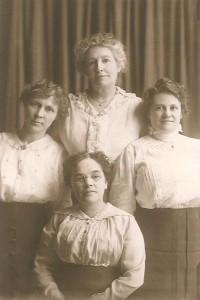
Perhaps the most fascinating and most moving aspect of Stevens County during The Great War were the women who kept it running. Much focus has been devoted to the actions and activities of the men, even in modern historiographies — yet little has been allocated for the role women played.
Women typically operated within a deferential framework, whether it was in a committee or in the household. Essentially, this means that the political and social preoccupations of women, particularly in Stevens County, revolved around notions of the “home.” Throughout the midwest citizens ”expected women’s political involvement to extend no further than service ‘to the people’ in the capacity of domestic partners and providers.”1Janet Lyon Discourse Vol. 17, No. 2, Insubordinate Bodies: Feminism, Spectacle, History (Winter 1994-1995), pp. 6-25
Indeed, in a bulletin from the United States Food Administration to the women in farming regions this particular expectation of behavior is crystalized. In attempting to provide productive behaviors to the farmwives of the midwest, the USFA implored women to try a few of the following:
1. Assisting local food administrator or deputy.
2. Assisting in organizing local food clubs, canning clubs, etc.
3. Assisting in demonstrating for local food clubs.
4. Rendering regular and dependable clerical services locally in war work.
5. Helping to duplicate and extend the use of war recipes.
6. Teaching in homes canning or drying methods, use of substitutes, etc.
7. Co-operating with the local newspapers, furnishing timely tested recipes, news stories of any good conservation banquets served in the community, comments on the condition of “war gardens”, etc.
8. Co-operating with the library by suggesting books, distributing literature, making posters on food conservation, etc.
9. Giving the message of food conservation to groups of children in story form.
10. Assisting in food work of child saving campaign.
11. Co-operating with the county or district home demonstration agent.
12. Co-operating with the county council of defense and their committees.2United States Food Administration, University Farm to Women in Stevens County, St. Paul, MN, 1918, Stevens County Historical Society.
A number of these activities have been illuminated in the sections beforehand. The women of Stevens County demonstrated continuously their resolve in eradicating wastefulness, promoting the education of children, and keeping the moral compass of the region in check. In 1917 at the outbreak of the war women created organizations quickly, devoted to the comfort and care of those affected—whether it be in the form of physical injury or lack of attention. In particular, the women who joined the Red Cross exhibited a fervor for contributing to the war effort in the form of materials. As of November 9, 1918, the Stevens County Chapter of The American Red Cross produced a total of 20,905 pieces:
146 abdominal bandages
175 four-tailed or head bandages
131 T bandages
10 many tailed bandages
1088 gauze compresses
940 folded gauze strips
2662 gauze sponges
10850 gauze wipes 2×2
1040 “” “” 4×4
984 cotton pads
264 paper back pads
241 split irrigation pads
792 oakum pads
10 5 yd. gauze rolls
42 1 “” “” “”
152 3 “” “” “”
60 muslin roller bandages
46 crinoline roller “”
48 flannel “” “”
100 scultetus (outing flannel)
873 shot bags3The American Red Cross, Stevens County Chapter, Quarterly Reports, Morris, MN, November 9, 1918, Stevens County Historical Society.
Women also organized contributed material goods through other channels. The Morris Knitting Committee, Stevens County Chapter met weekly, producing wristlets, washcloths, sponges, helmets, bands, trench caps, as well as socks. J. W. Harris, chairman of the committee noted that “the needles and tongues clicked merrily” whenever these women came together. The overall list of materials produced was considerably higher than one might think. For example, 4Harris, J.W.., Chairman of the Stevens County Chapter—Morris Knitting Committee, Morris, Minn, n.d., Stevens County Historical Society, Morris, MN
Of all the women known for their work throughout Stevens County during the Great War, none were so revered and respected as Ida B. Hancock. Ida operated as the Madam Chairman of the Women’s Auxiliary of the Commission of Public Safety 5Hancock, Ida. B., Chairman of Women’s Auxiliary of the Commission of Public Safety to Josephine Baker, n.d., Stevens County Historical Society, Morris, MN.. A quote from a letter she wrote to her fellow committee members after the war’s end illustrates perhaps best her preoccupation with all things.
Now that the war is over and the great need of Red Cross work is over and NATIONAL Prihibition [sic] Laws have been passed, we feel that our work has not ended, but has just begun. Law enforcement must be looked after. Americanization and education of the foreigners who come to our land, womans rights and child welfare to be had and the great work of educating the young against the use of narcotics, also our aims to make the WORLD DRY by 1930. We have great work yet to do.
IT IS FOOD THAT WILL WIN THE WAR–TO DEVELOP PATRIOTISM AND TRUE AMERICAN CITIZENSHIP
References
| ↑1 | Janet Lyon Discourse Vol. 17, No. 2, Insubordinate Bodies: Feminism, Spectacle, History (Winter 1994-1995), pp. 6-25 |
|---|---|
| ↑2 | United States Food Administration, University Farm to Women in Stevens County, St. Paul, MN, 1918, Stevens County Historical Society. |
| ↑3 | The American Red Cross, Stevens County Chapter, Quarterly Reports, Morris, MN, November 9, 1918, Stevens County Historical Society. |
| ↑4 | Harris, J.W.., Chairman of the Stevens County Chapter—Morris Knitting Committee, Morris, Minn, n.d., Stevens County Historical Society, Morris, MN |
| ↑5 | Hancock, Ida. B., Chairman of Women’s Auxiliary of the Commission of Public Safety to Josephine Baker, n.d., Stevens County Historical Society, Morris, MN. |